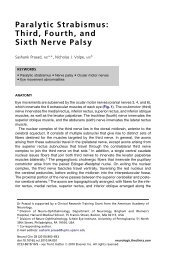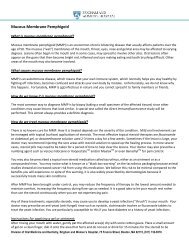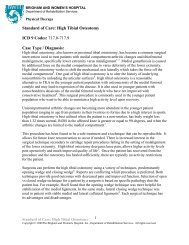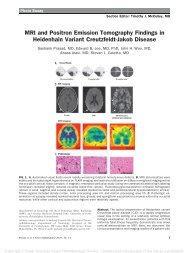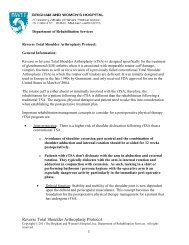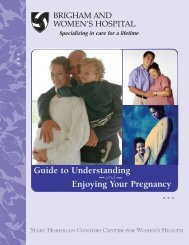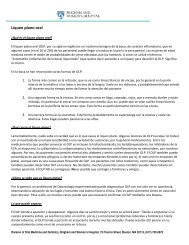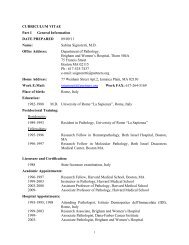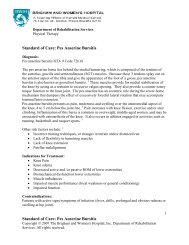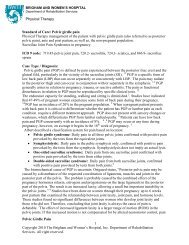Laparoscopic Myomectomy - Brigham and Women's Hospital
Laparoscopic Myomectomy - Brigham and Women's Hospital
Laparoscopic Myomectomy - Brigham and Women's Hospital
Create successful ePaper yourself
Turn your PDF publications into a flip-book with our unique Google optimized e-Paper software.
Submucosal <strong>and</strong><br />
intracavitary fibroids<br />
smaller than 4 cm<br />
<strong>and</strong> more than 5 mm<br />
away from the<br />
uterine serosa are<br />
generally removed<br />
hysteroscopically<br />
52<br />
SURGICAL TECHNIQUES / LAPAROSCOPIC MYOMECTOMY<br />
At our institution, we do not have firm<br />
guidelines in place for the number <strong>and</strong> size of<br />
fibroids that can be removed laparoscopically.<br />
Other variables enter into decision-making<br />
<strong>and</strong> counseling, among them any medical comorbidity<br />
or history of uterine surgery the patient<br />
may have, as well as her desires in regard<br />
to childbearing <strong>and</strong> uterine retention.<br />
Hysterectomy may be the most straightforward<br />
option for women who have symptomatic<br />
fibroids <strong>and</strong> who have completed<br />
childbearing. However, myomectomy is also<br />
appropriate as long as the patient is aware of<br />
the risk that fibroids may recur <strong>and</strong> the potential<br />
for further surgery. When the patient is in<br />
her late 40s or early 50s, the likelihood of fibroid<br />
recurrence may be lower than it is in the<br />
general population.<br />
In my practice, submucosal <strong>and</strong> intracavitary<br />
fibroids smaller than 4 cm <strong>and</strong> more than<br />
5 mm away from the uterine serosa are generally<br />
removed hysteroscopically, an approach<br />
beyond the scope of this article. In women<br />
who have completed childbearing but who<br />
wish to conserve the uterus, we deliberately<br />
enter the uterine cavity laparoscopically because<br />
this strategy allows for efficient removal<br />
of submucosal <strong>and</strong> intracavitary fibroids.<br />
Estimate the<br />
2. duration of surgery<br />
When the patient has fibroids that are intramural<br />
or subserosal, our general rule of thumb<br />
is to determine her suitability for laparoscopic<br />
myomectomy, based on the estimated duration<br />
of the operation. A surgeon’s ability to<br />
calculate the length of the operation for a particular<br />
patient increases with experience.<br />
We tend to recommend the laparoscopic<br />
approach when the procedure is expected to<br />
take less than 3 hours to complete. More than<br />
95% of our patients fall into this category.<br />
When we anticipate a prolonged operating<br />
time, we discuss the option of h<strong>and</strong>-assisted<br />
laparoscopic myomectomy. This approach<br />
involves two or three 5-mm trocar punctures<br />
high on the abdomen in conjunction with a<br />
suprapubic incision, 6 to 7 cm in length with<br />
a h<strong>and</strong> port in place. Prospective studies have<br />
OBG Management | March 2010 | Vol. 22 No. 3<br />
demonstrated a significantly longer recovery<br />
with minilaparotomy than with laparoscopy,<br />
but these trials compared uteri of similar<br />
size. 4,8 We expect the laparoscopic approach to<br />
confer fewer advantages when operative time<br />
is prolonged significantly.<br />
In our practice, we consider one or more<br />
of the following conditions appropriate for<br />
h<strong>and</strong>-assisted laparoscopic myomectomy:<br />
• a very large uterus (i.e., heavier than<br />
1,500 to 2,000 g). In these cases, operating<br />
times can be excessive because of the<br />
need for extensive suturing <strong>and</strong> morcellation,<br />
<strong>and</strong> bleeding may increase as a result<br />
• more than 20 fibroids on magnetic resonance<br />
imaging (MRI). It can be a challenge<br />
to locate all of the fibroids; multiple<br />
uterine incisions may be necessary<br />
• a medical comorbidity that renders the<br />
patient unable to tolerate prolonged anesthesia.<br />
For example, we operated on a patient<br />
who had Ehlers-Danlos syndrome <strong>and</strong><br />
who needed to avoid a prolonged operation<br />
due to fragile bones <strong>and</strong> joint laxity.<br />
Of necessity, these guidelines will vary<br />
from practice to practice, <strong>and</strong> gynecologic<br />
surgeons who are just beginning to perform<br />
laparoscopic myomectomy should not include<br />
multiple fibroids or a large uterus among their<br />
initial cases. Instead, perform the first few cases<br />
in patients who have not had abdominal surgery<br />
<strong>and</strong> who have a symptomatic intramural<br />
or subserosal fibroid that is close to the uterine<br />
fundus <strong>and</strong> no larger than 6 cm in diameter.<br />
3. Consider<br />
preoperative MRI<br />
Preoperative imaging greatly supplements<br />
the clinical examination <strong>and</strong> facilitates<br />
identification of the number, location, <strong>and</strong><br />
characteristics of the fibroids. Pelvic ultrasonography<br />
(US) is appropriate for most patients.<br />
We prefer preoperative MRI of the<br />
pelvis in the following scenarios:<br />
• uterus larger than 12 weeks (280 g) on<br />
clinical examination<br />
• identification of multiple fibroids via US<br />
• history suggestive of adenomyosis.<br />
MRI facilitates preoperative planning by<br />
CONTINUED ON PAGE 53



